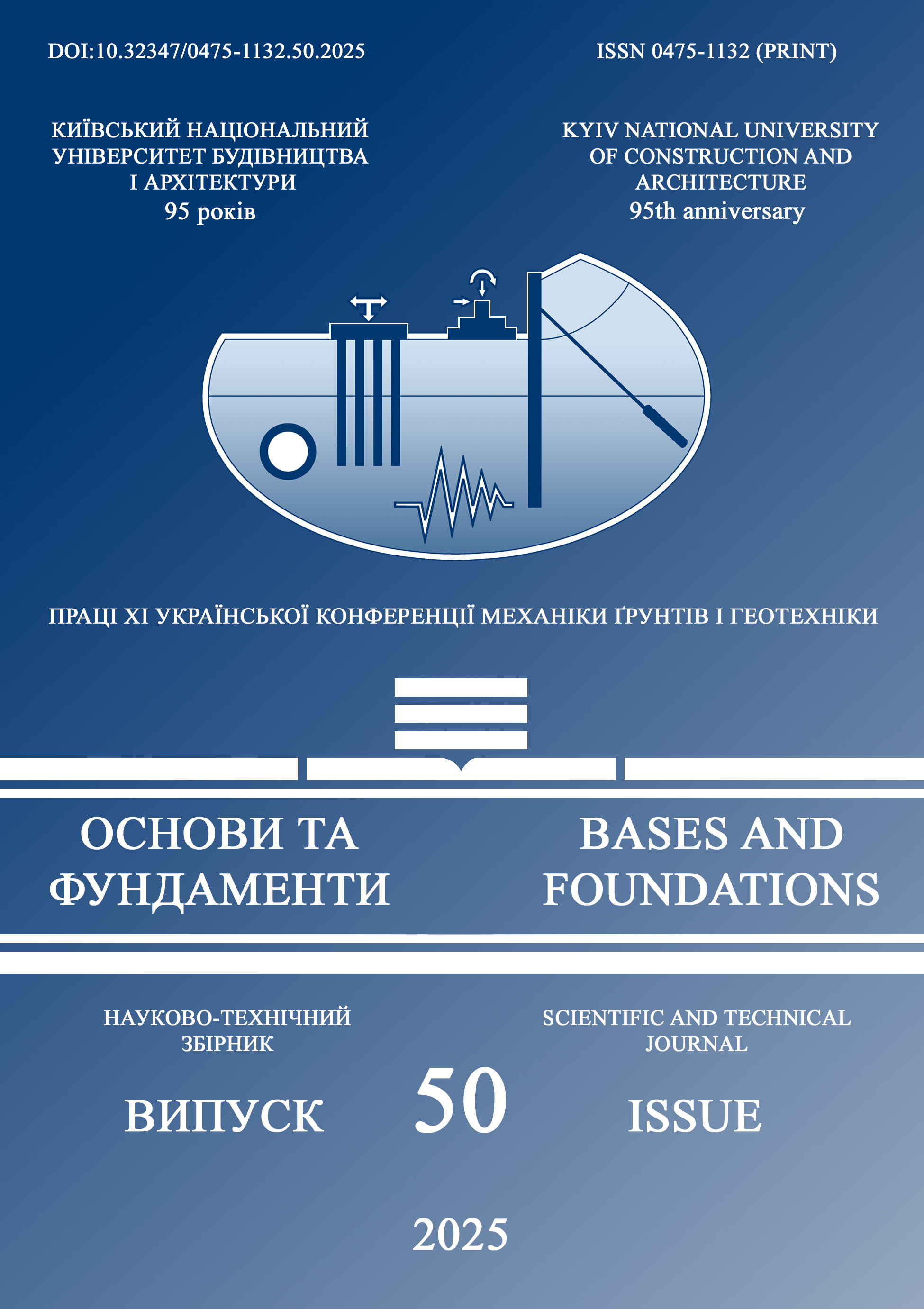Оцінка впливу імпульсного навантаження спричиненого вибухом та ударом на заглиблені захисні споруди та ґрунтове середовище
Основний зміст сторінки статті
Анотація
Розрахунок заглиблених у ґрунтове середовище захисних споруд на дію імпульсного навантаження викликаного вибухом або ударом є комплексною проблемою, яка вимагає знання сучасного фізико-математичного апарату опису швидкоплинних процесів деформування різних за міцністю та жорсткістю матеріалів. Для розв’язання задач такого типу сьогодні найчастіше використовують числове моделювання і його результати залежать від коректності створення розрахункової моделі, вибору методу побудови та роботи сітки скінченних елементів, вибору моделей поведінки матеріалів та їх параметрів для ґрунту, бетону, сталевої арматура, що дозволяють описати поведінку споруди та ґрунтового середовища при швидкоплинних і великих деформаціях, а також враховують зміну параметрів матеріалів при імпульсному (короткочасному) впливі у порівнянні з статичними (довготривалими) навантаженнями.
В роботі представлені результати оцінки впливу вибуху та удару на заглиблену у грунт захисну споруду виконані у програмному комплексі Ansys/LS-Dyna. Споруда, що аналізувалась є модульною конструкцією яка складається з двох крупнорозмірних залізобетонних елементів, занурена в ґрунтове середовище, в якості якого обраний піщаний ґрунт.
При створенні розрахункової моделі заглиблена споруда моделювалась сіткою Лагранжа, а ґрунт, повітря, простір навколо заглибленої споруди та зона вибуху за допомогою сітки Ейлера. Такий підхід дає змогу використати переваги обох методів.
Розрахунки на дію впливу вибухової ударної хвилі спричиненої вибухівкою масою 50 кг у тротиловому еквіваленті проводилися для трьох варіантів заглиблення споруди: обсипка ґрунтом товщиною 0,5 м; заглиблення в грунт на 1,0 м та на 1,5 м. Досліджено, що збільшення глибини занурення споруди з 0,5 м до 1 м зменшує тиск, що виникає на поверхні споруди в 20 разів, її переміщення зменшуються в 4 рази, напруження в арматурі зменшуються на 68% та значно менше розміри зони пластичних деформацій.
При дослідженні впливу від удару снаряду масою 200 кг, що рухається зі швидкістю 50 м/с під кутом 60° до поверхні ґрунту споруда занурювалась на глибину 0,1 м та 0,5 м. Встановлено, що збільшення глибини занурення споруди знижує ступінь пошкодження заглибленої споруди, кількість пошкоджених ударом зон при збільшені з 0,1м до 0,5м зменшується на 80% тобто ґрунтовий прошарок товщиною 0,5м добре виконує демпфуючу функцію.
Блок інформації про статтю

Ця робота ліцензується відповідно до Creative Commons Attribution 4.0 International License.
Автори, які публікуються у цьому журналі, погоджуються з наступними умовами: Автори залишають за собою право на авторство своєї роботи та передають журналу право першої публікації цієї роботи на умовах ліцензії Creative Commons Attribution License, котра дозволяє іншим особам вільно розповсюджувати опубліковану роботу з обов'язковим посиланням на авторів оригінальної роботи та першу публікацію роботи у цьому журналі. Автори мають право укладати самостійні додаткові угоди щодо неексклюзивного розповсюдження роботи у тому вигляді, в якому вона була опублікована цим журналом (наприклад, розміщувати роботу в електронному сховищі установи або публікувати у складі монографії), за умови збереження посилання на першу публікацію роботи у цьому журналі. Політика журналу дозволяє і заохочує розміщення авторами в мережі Інтернет (наприклад, у сховищах установ або на особистих веб-сайтах) рукопису роботи, як до подання цього рукопису до редакції, так і під час його редакційного опрацювання, оскільки це сприяє виникненню продуктивної наукової дискусії та позитивно позначається на оперативності та динаміці цитування опублікованої роботи (див. The Effect of Open Access).Посилання
Bojanowski, C., & Kulak, R. F. (2010, June). Comparison of lagrangian, SPH and MM-ALE approaches for modeling large deformations in soil. In 11th International LS-DYNA® Users Conference, Dearborn, MI, pp11-45 to (pp. 11-55).
Tabatabaei, Z. S., & Volz, J. S. (2012, June). A comparison between three different blast methods in LS-DYNA: LBE, MM-ALE, Coupling of LBE and MM-ALE. In 12th In-ternational LS-DYNA Users Conference (Vol. 3, pp. 1-10).
Barsotti, M., Sammarco, E., & Stevens, D. (2016). Comparison of strategies for landmine modelling in LS-DYNA with sandy soil material model development. In Proceedings of 14th international LS-DYNA users conference, June (pp. 12-14).
Schwer, L. (2010, October). A brief introduction to coupling load blast enhanced with Multi-Material ALE: the best of both worlds for air blast simulation. In German LS-DYNA Forum (Vol. 2, No. 3, pp. 205-11).
Slavik, T. P. (2010, June). A coupling of empirical explosive blast loads to ALE air domains in LS-DYNA®. In IOP Conference Series: Materials Science and Engineer-ing (Vol. 10, No. 1, p. 012146). IOP Publishing.
Nazhat, Y. N. Y. (2013). Behaviour of sandy soil subjected to dynamic loading.
Jayasinghe, L. B., Thambiratnam, D. P., Perera, N., & Jayasooriya, J. H. A. R. (2013). Computer simulation of underground blast response of pile in saturated soil. Computers and Structures, 120, 86‑95.
Koneshwaran, S. (2014). Blast response and sensitivity analysis of segmental tunnel (Doctoral dissertation, Queensland Uni-versity of Technology).
Van Dorsselaer, N., Lapoujade, V., Nahas, G., Tarallo, F., & Rambach, J. M. (2012, June). General Approach for Concrete Modeling: Impact on Reinforced Concrete. In 12th International LS-DYNA® Users Conference, Dearborn.
Sangi, A. J., & May, I. M. (2009, May). High-mass, low-velocity impacts on reinforced concrete slabs. In 7th European LS-DYNA conference.
LS-DYNA, Livermore software technolo-gy cooperation, LS-DYNA keyword user’s manual, 2025.
LS-DYNA, Livermore software technolo-gy cooperation, LS-DYNA material models manual, 2025.
